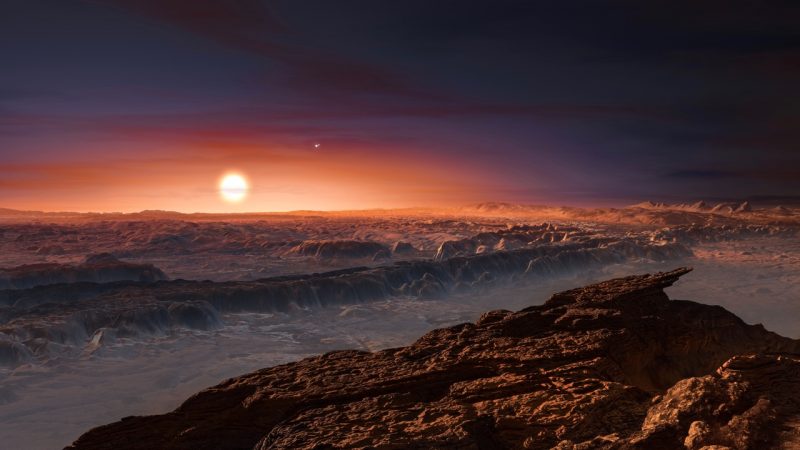
Artist's conception of the view from the new planet circling the star Proxima Centauri B
It appears every time a new exoplanet is discovered, the hype of astronomers (and some physicists) approaches that of the media commentariat. Three days ago on CBS Early Show, for example, physicist Michio Kaku was heard to blab that "the holy grail of astronomy is to find an earth like planet that supports life." Not really. The true "holy grail", if such a term can be applied to astronomy, would be to forge a consistent theory of stellar evolution by which each stage of a star's life cycle can be matched to an exact sequence of nuclear fusion reactions and reaction cross sections. But, of course, this would likely be too complex for wide consumption.
Enter now a new exoplanet (in terms of its discovery) orbiting the star Proxima Centauri B in the triple star Alpha Centauri system, roughly 4.3 light years distant. Its discovery began with an observing program called Pale Red Dot, in early 2016. This was under the auspices of the European Southern Observatory (ESO). (Not all exoplanet finds have been via the Kepler space observatory). In the case of Pale Red Dot, the goal was, specifically, to find a planet for this star. This sounds somewhat like putting "the cart before the horse" and in many ways it was. But the ESO team had goon reason: namely, why shouldn't Earth's nearest neighbor star not have a planet or even planetary system?
Now ESO and several other institutions have released statements on their new discovery that yes, there is a new planet. Even better it's only slightly more massive than Earth. Yes, it’s in Proxima Centauri’s habitable zone, meaning there’s a potential for liquid water to exist on its surface.
The journal Nature is due to publish a paper describing the new planet – which is called Proxima b – on August 25, 2016. Guillem Angada -Escude, an astrophysicist at Queen Mary University, London, said:
"The long-sought world … orbits its cool red parent star every 11 days and has a temperature suitable for liquid water to exist on its surface. This rocky world is a little more massive than the Earth and is the closest exoplanet to us — and it may also be the closest possible abode for life outside the solar system."
Of the three stars in the system, Proxima – a small red dwarf star – is the closest star. Read about the Alpha Centauri system here. Using Kepler's harmonic law or 3rd law of planetary motion, e.g.
http://brane-space.blogspot.com/2011/08/solution-to-simple-astronomy-problems-6.html
We can compute that the distance of Proxima b from its parent star is just over 4.6 million miles, or a factor twenty less distance than Earth is from the Sun. But bear in mind the red dwarf sun is a much cooler star. This means Proxima is plausibly in the not too hot, not too cold "Goldilocks zone". If that is so it is possible that planet also has an atmosphere.

The radial velocity (RV) plot shown above shows the variations in motion of Proxima Centauri over the first part of 2016. The negative values denote approaching velocities in km/hr and the positive values denote receding velocities, i.e. when the component is moving away from Earth. Thus, at some times it is approaching at ~ 5 km/hr and at other times receding at the same speed. As Anglada Escude explained:
"At times Proxima Centauri is approaching Earth at about 3 miles (5 km) per hour — normal human walking pace — and at times receding at the same speed. This regular pattern of changing radial velocities repeats with a period of 11.2 days. Careful analysis of the resulting tiny Doppler shifts showed that they indicated the presence of a planet with a mass at least 1.3 times that of the Earth, orbiting about 4 million miles (7 million km) from Proxima Centauri — only 5% of the Earth-sun distance."
The greater mass of the planet, of course, means a higher g-value, i.e. for gravitational acceleration. So any Earthman arriving there would weigh more than on Earth. Thus:
g(Proxima b) = G M/ r2
Where G is the Newtonian gravitational constant, M is then 1.3 x Earth's mass ( 6.0 x 1024 kg) and r is the radius of the planet.
And the weight would be m g(Proxima b) where m is the Earther's mass in kilograms. (Note: Mass is an inherent property of matter, denoting the number of particles possessed, and hence doesn't change assuming a non-relativistic environment)
According to investigator Angada -Escude:
"The first hints of a possible planet were spotted back in 2013, but the detection was not convincing. Since then we have worked hard to get further observations off the ground with help from ESO and others. The recent Pale Red Dot campaign has been about two years in the planning."
When combined with earlier observations then, the Pale Red Dot data revealed the new planet, Proxima b.
Obviously, further investigations are still needed to confirm Proxima b's other apparent peculiarities including that the planet doesn't rotate so one side is always facing its star while the other is darker and colder. Add the fact that it is also bombarded with ultraviolet light and x-rays and one can understand why it may be best at this point to contain the hype.
No comments:
Post a Comment